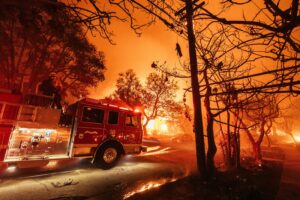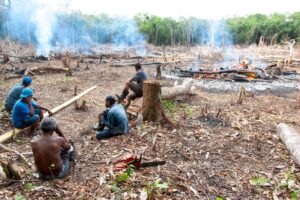Since its last major famine more than a decade ago, Somalia has received well over a billion dollars a year in humanitarian aid. But that spending – aimed at meeting immediate basic needs for food and water in the conflict-ravaged Horn of Africa country – has not reduced demands for help, which are instead rising as climate change brings more frequent and severe floods and droughts.
With supplies of international aid increasingly falling short around the world as the number and scale of crises and disasters grows, humanitarian groups are trying out new approaches to close the gap, including “anticipatory action” which pushes small amounts of cash to those in the path of a looming disaster, to help them better protect themselves and their assets.
In countries such as Bangladesh, with strong early warning systems and disaster-reduction mechanisms in place, such efforts have been shown to cut losses by about $7 for each $1 invested. But in the world’s most fragile and conflict-affected states – from Somalia to Afghanistan, and Iraq to Chad – systems like this are often missing.
Reducing humanitarian needs and boosting resilience there will require building basic infrastructure, something that can only happen if development, peace-building and relief groups – and their funders – get out of their comfort zones and overcome obstacles to working together, resilience researchers say.
“The only way to get ahead of a disaster is not by mitigating its effects but by avoiding it happening in the first place – by investing in disaster-risk reduction and climate adaptation,” said Mauricio Vazquez, who leads work on climate change and conflict at ODI Global, a London-based think-tank.
“You don’t need to wait for a bad weather forecast to do something. Anticipatory action done by humanitarians doesn’t create opportunities for people, it just helps make the best of a situation,” he said in an interview with Climate Home.
Weak governance exposes people
Abdihakim Ainte, director of climate change for Somalia’s prime minister, agreed that “vulnerability primarily stems from the dysfunction of key institutions.”
“The weaker the institutions, the more susceptible people are to every shock and disruption,” he told Climate Home.
At last year’s COP28 climate talks, more than 100 countries, banks and other organisations issued a call for “collective action to build climate resilience at the scale and speed required in highly vulnerable countries and communities, particularly those threatened or affected by fragility or conflict.”
Innovative efforts to make that happen are ramping up. Financiers including the African Development Bank, for instance, are increasingly trying to move development cash through peace-building and humanitarian groups on the ground in conflict-hit areas.
The bank has signed an agreement with the International Federation of Red Cross and Red Crescent Societies (IFRC), an organisation that “has the ability to operate in very insecure environments. They stay there – they’ve been there for decades,” said Fredrick Teufel, the bank’s lead coordinator of efforts to boost its investments in fragile contexts.
The IFRC focuses on using humanitarian grants to deliver short-term aid. But in places like conflict-plagued Goma, in the eastern Democratic Republic of Congo, or in Somalia, “there’s no reason they cannot use that delivery capacity there to also advance irrigation (or) community-based solar,” Teufel said in an interview with Climate Home.
Humanitarian groups can give funders crucial and otherwise unavailable insights into what communities affected by conflict themselves see as the most useful investments, he said, noting that “they all want development solutions, not another bag of rice.”
But significant institutional obstacles stand in the way of scaling up such cooperation, including a need by humanitarian groups to be seen as neutral in conflict zones, and accounting rules that require different types of development and climate funding to be kept in separate pots to avoid double counting.
Humanitarian action limited
In Goma, in the Democratic Republic of Congo, the International Committee of the Red Cross (ICRC), which focuses on protecting victims of armed conflict, is working with development partners and funders over seven years to rehabilitate and expand the Goma West water system – a project that serves both development and humanitarian needs.
But such projects don’t lead to meeting broad country-level needs, warned Catherine-Lune Grayson, head of policy at the ICRC.
In order to protect their ability to access conflict-hit communities, humanitarian groups need to carefully avoid taking sides in political disputes – and choices about partners and where to spend development money are often political.
“We have to tread a fine line. Where do we join forces, and where do we need to keep a healthy distance so it’s not read as too political?” Grayson asked, emphasising the need for “complementary” rather than “joint” work.
Scale is another issue. “We can help rehabilitate the water system in Goma, but you cannot ask the ICRC to restore and expand all water systems across the country. We will say we’re not equipped to do this,” she said.
Still, the view that countries struggling with conflict are not the sole responsibility of humanitarian agencies is fortunately growing, she said.
“A few years ago, there would not even have been a discussion about this. There’s been a real shift,” she added.
Maladaptation?
The different time horizons of humanitarian groups – focused on meeting short-term needs – and development actors – focused on longer-term aims – are another area that needs attention as groups try to work together, said Manisha Gulati, a global risks and resilience researcher with ODI Global.
In Somalia, for instance, wells and water storage are often being built to meet immediate humanitarian demand – but analysis by ODI researchers suggests the money is not being spent where it will be most needed in the future, as climate change impacts strengthen, she said.
“We have mapped where water insecurity is now and where it will get worse – and that’s where we should be thinking about. That’s how we prevent the next drought and humanitarian crisis,” Gulati said.
Today “we’re digging wells that won’t work in the long term. It’s maladaptation and we’re not using finance well if we’re using it in a manner where in the next 5-10 years we create a problem,” she said.
Simply improving communication among those working to solve problems in armed conflict areas is one way to move ahead, Gulati said. “How do we talk about collective action when agencies have no idea what the others are doing?” she asked.
Ainte, of Somalia, said efforts to win resources for crucial development in conflict-hit countries – a challenge as development aid stagnates – can often come into conflict with appeals for humanitarian aid, which keep the focus on vulnerability.
“The humanitarian narrative has to change to a development narrative. Somalia has resources that need to be invested in. We need that kind of mentality, that we are a country that has potential and deserves investment, rather than a country that has a problem,” he said.
Need to fix systems
But winning funding to boost development and create resilient systems in fragile countries will also require the countries themselves to step up, including cutting corruption and building stronger guardrails to ensure funds are used effectively, Gulati said.
“They need to understand it’s not a one-way street – they have to make an equal effort and adjustments,” she said. “You might get $100 million – but you won’t get more unless you fix the basics in your systems.”
With climate impacts surging and almost two-thirds of the world’s extreme poor expected to live in countries that are fragile or conflict-affected by 2030, the stakes for getting this cooperation right are growing, she added.
“We can keep throwing money at the humanitarian problem, but we’re not reducing the caseload,” she said. “We need to address the basic vulnerabilities that are leading to this situation. If we don’t do that, we’re not going to solve the problem.”
Sponsored by ODI Global and the Climate, Peace and Transboundary Resilience Pavilion at COP29. See our supporters page for what this means.
Laurie Goering is a freelance writer and editor based in London, UK.
The Climate, Peace and Transboundary Resilience Pavilion at COP29 will host 30 events with world-leading experts, including heads of state and other leading representatives from governments, climate funds, aid agencies, civil society organisations, and more. All events will be livestreamed. For more information visit the Pavilion page here.
The post Aid agencies grapple with climate adaptation in fragile states appeared first on Climate Home News.
Aid agencies grapple with climate adaptation in fragile states
Climate Change
UN report: Five charts showing how global deforestation is declining
The amount of forest lost around the world has reduced by millions of hectares each year in recent decades, but countries are still off track to meet “important” deforestation targets.
These are the findings of the Global Forest Resources Assessment – a major new report from the UN’s Food and Agriculture Organization – which says that an estimated 10.9m hectares (Mha) of land was deforested each year between 2015 and 2025.
This is almost 7Mha less than the amount of annual forest loss over 1990-2000.
Since 1990, the area of forest destroyed each year has halved in South America, although it still remains the region with the highest amount of deforestation.
Europe was the only region in the world where annual forest loss has increased since 1990.
Agriculture has historically been the leading cause of deforestation around the world, but the report notes that wildfires, climate change-fuelled extreme weather, insects and diseases increasingly pose a threat.
The Global Forest Resources Assessment is published every five years. The 2025 report compiles and analyses national forest data from almost every country in the world over 1990-2025.
Carbon Brief has picked out five key findings from the report around deforestation, carbon storage and the amount of forest held within protected areas around the world.
1. Rates of deforestation are declining around the world
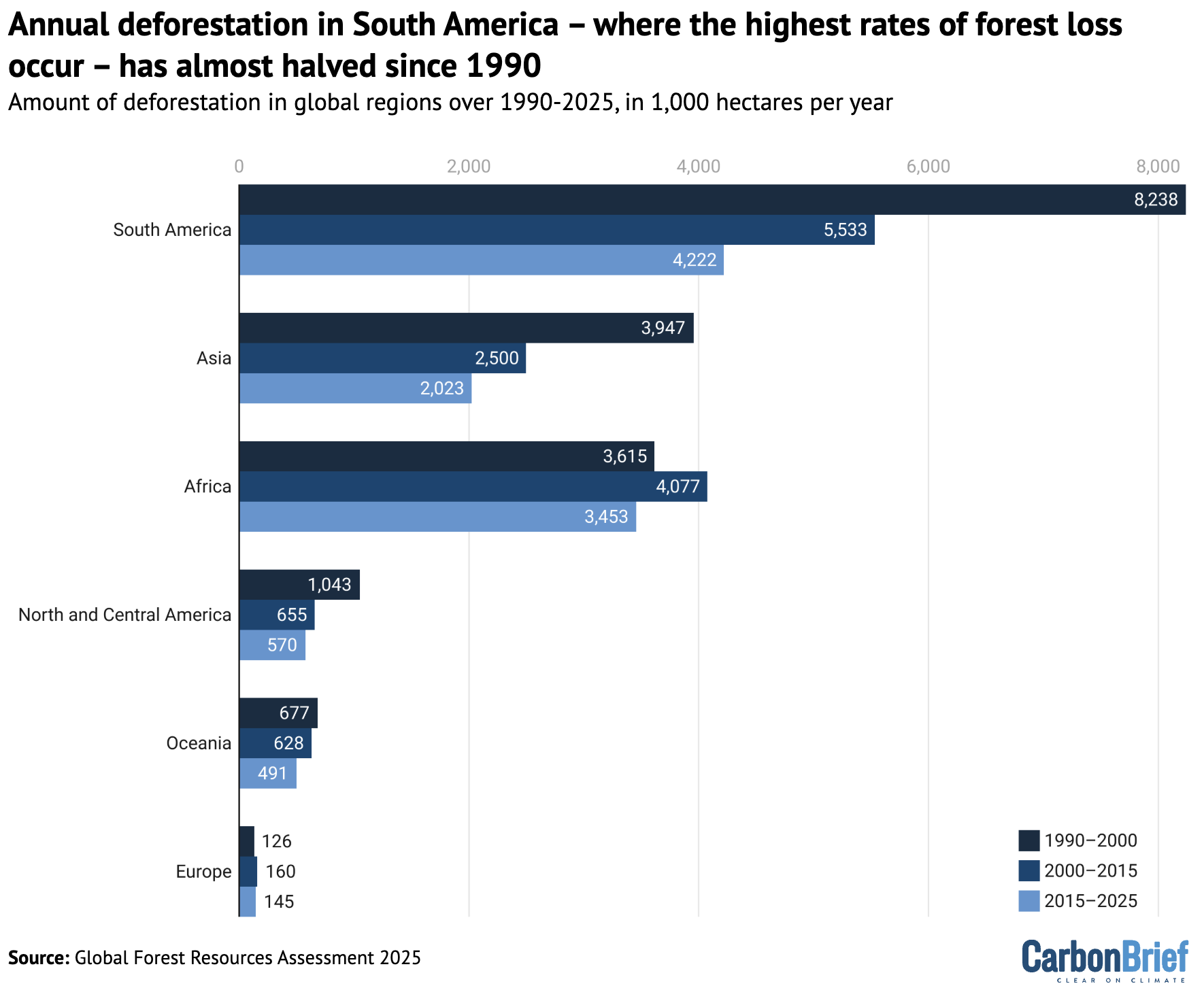
Rates of annual deforestation, in thousands of hectares, in South America, Asia, Africa, North and Central America, Oceania and Europe over 1990-2000 (dark blue), 2000-15 (medium blue) and 2015-25 (light blue). Source: Global Forest Resources Assessment 2025
In total, around 489Mha of forest have been lost due to deforestation since 1990, the new report finds. Most of this – 88% – occurred in the tropics.
This breaks down to around 10.9Mha of forest lost each year between 2015 and 2025, a reduction compared to 13.6Mha of loss over 2000-15 and 17.6Mha over 1990-2000.
Deforestation refers to the clearing of a forest, typically to repurpose the land for agriculture or use the trees for wood.
The chart above shows that South America experiences the most forest loss each year, although annual deforestation levels have halved from 8.2Mha over 1990-2000 to 4.2Mha over 2015-25.
Annual deforestation in Asia also saw a sizable reduction, from 3.9Mha over 1990-2000 to 2Mha over 2015-25, the report says.
Europe had the lowest overall deforestation rates, but was also the only region to record an increase over the last 35 years, with deforestation rates growing from 126,000 hectares over 1990-2000 to 145,000 hectares in the past 10 years.
Despite the downward global trend, FAO chief Dr Qu Dongyu notes in the report’s foreword that the “world is not on track to meet important global forest targets”.
In 2021, more than 100 countries pledged to halt and reverse global deforestation by 2030. But deforestation rates in 2024 were 63% higher than the trajectory needed to meet this 2030 target, according to a recent report from civil society groups.
The goals of this pledge were formally recognised in a key text at the COP28 climate summit in Dubai in 2023, which “emphasise[d]” that halting and reversing deforestation and forest degradation by 2030 would be key to meeting climate goals.
2. Global net forest loss has more than halved since 1990
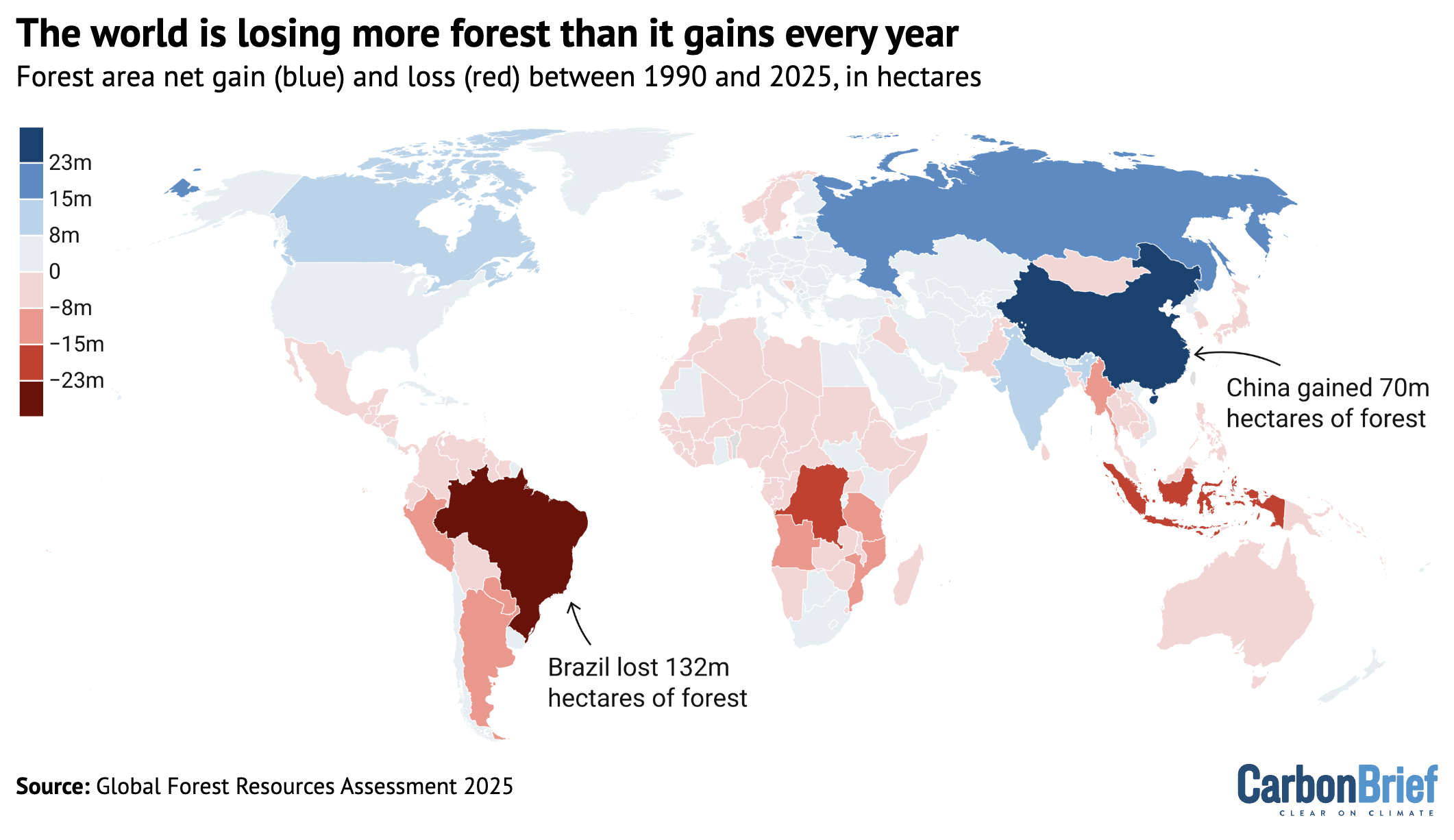
Forest area net change by country between 1990 and 2025, in hectares. Source: Global Forest Resources Assessment 2025
The new report finds that forests cover more than 4bn hectares of land, an area encompassing one-third of the planet’s land surface.
More than half of the world’s forested area is located in just five countries: Russia, Brazil, Canada, the US and China.
The map above shows that, overall, more forest is lost than gained each year around the world. There was 6.8Mha of forest growth over 2015-25, but 10.9Mha of forest lost.
The annual rate of this global net forest loss – the amount that deforestation has exceeded the amount regrown – has more than halved since 1990, dropping from 10.7Mha over 1990-2000 to 4.1Mha over 2015-25.
The report says this change was due to reduced deforestation in some countries and increased forest expansion in others. However, the rate of forest expansion has also slowed over time – from 9.9Mha per year in 2000-15 to 6.8Mha per year in 2015-25.
There are many driving factors behind continuing deforestation. Agriculture has historically been the leading cause of forest loss, but wildfire is increasingly posing a threat. Wildfires were the leading driver of tropical forest loss in 2024 for the first time on record, a Global Forest Watch report found earlier this year.
The new UN report says that an average of 261Mha of land was burned by fire each year over 2007-19. Around half of this area was forest. Around 80% of the forested land impacted by fires in 2019 was in the subtropics – areas located just outside tropical regions, such as parts of Argentina, the US and Australia.
The report notes that fire is widely used in land management practices, but uncontrolled fires can have “major negative impacts on people, ecosystems and climate”.
It adds that researchers gathered information on fires up as far as 2023, but chose to focus on 2007-19 due to a lack of more recent data for some countries.
A different report from an international team of scientists recently found that fires burned at least 370Mha of land – an area larger than India – between March 2024 and February 2025.
3. Many countries are hugely increasing their forest area
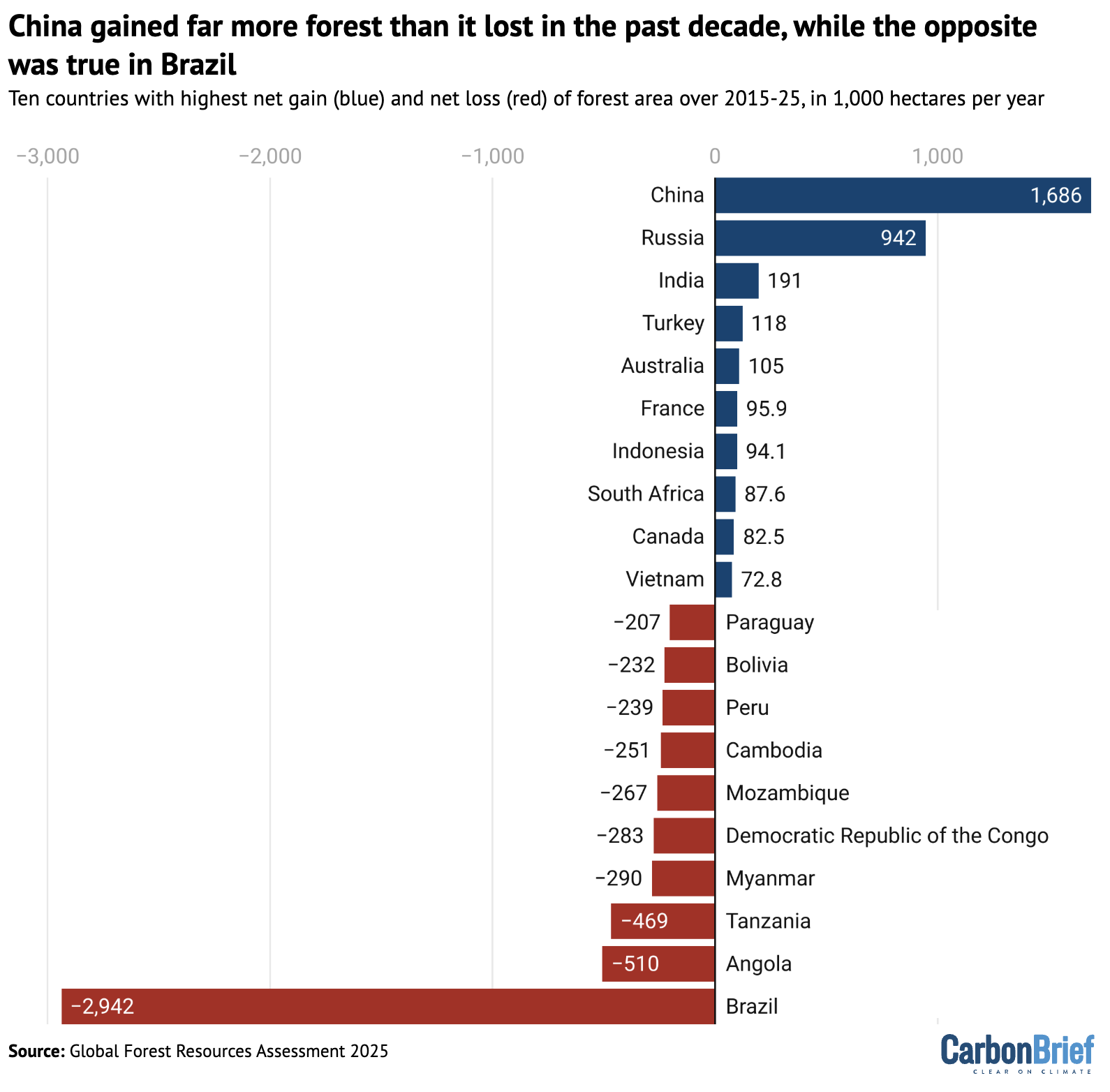
Top 10 countries for annual net gain (blue) and net loss (red) of forest area over 2015-25, in 1,000 hectares per year. Source: Global Forest Resources Assessment 2025
Globally, deforestation is declining, but the trend varies from country to country.
The chart above shows that some nations, such as China and Russia, added a lot more forest cover than they removed in the past decade through, for example, afforestation programmes.
But in other countries – particularly Brazil – the level of deforestation far surpasses the amount of forest re-grown.
Deforestation in Brazil dropped by almost one-third between 2023 and 2024, news outlet Brasil de Fato reported earlier this year, which was during the time Luiz Inácio Lula da Silva took over as president. The new UN report finds that, on average, Brazil lost 2.9Mha of forest area each year over 2015-25, compared to 5.8Mha over 1990-2000.
Russia’s net gain of forest cover increased significantly since 1990 – growing from 80,400ha per year in 1990-2000 to 942,000ha per year in 2015-25.
In China, although it is also planting significant levels of forest, the forest level gained has dropped over time, from 2.2Mha per year in 2000-15 to 1.7Mha per year in 2015-25.
Levels of net forest gain in Canada also fell from 513,000ha per year in 2000-15 to 82,500ha per year in 2015-25.
In the US, the net forest growth trend reversed over the past decade – from 437,000ha per year of gain in 2000-15 to a net forest loss of 120,000ha per year from 2015 to 2025.
Oceania reversed a previously negative trend to gain 140,000ha of forests per year in the past decade, the report says. This was mainly due to changes in Australia, where previous losses of tens of thousands of hectares each year turned into an annual net gain of 105,000ha each year by 2015-25.
4. The world’s forests hold more than 700bn tonnes of carbon
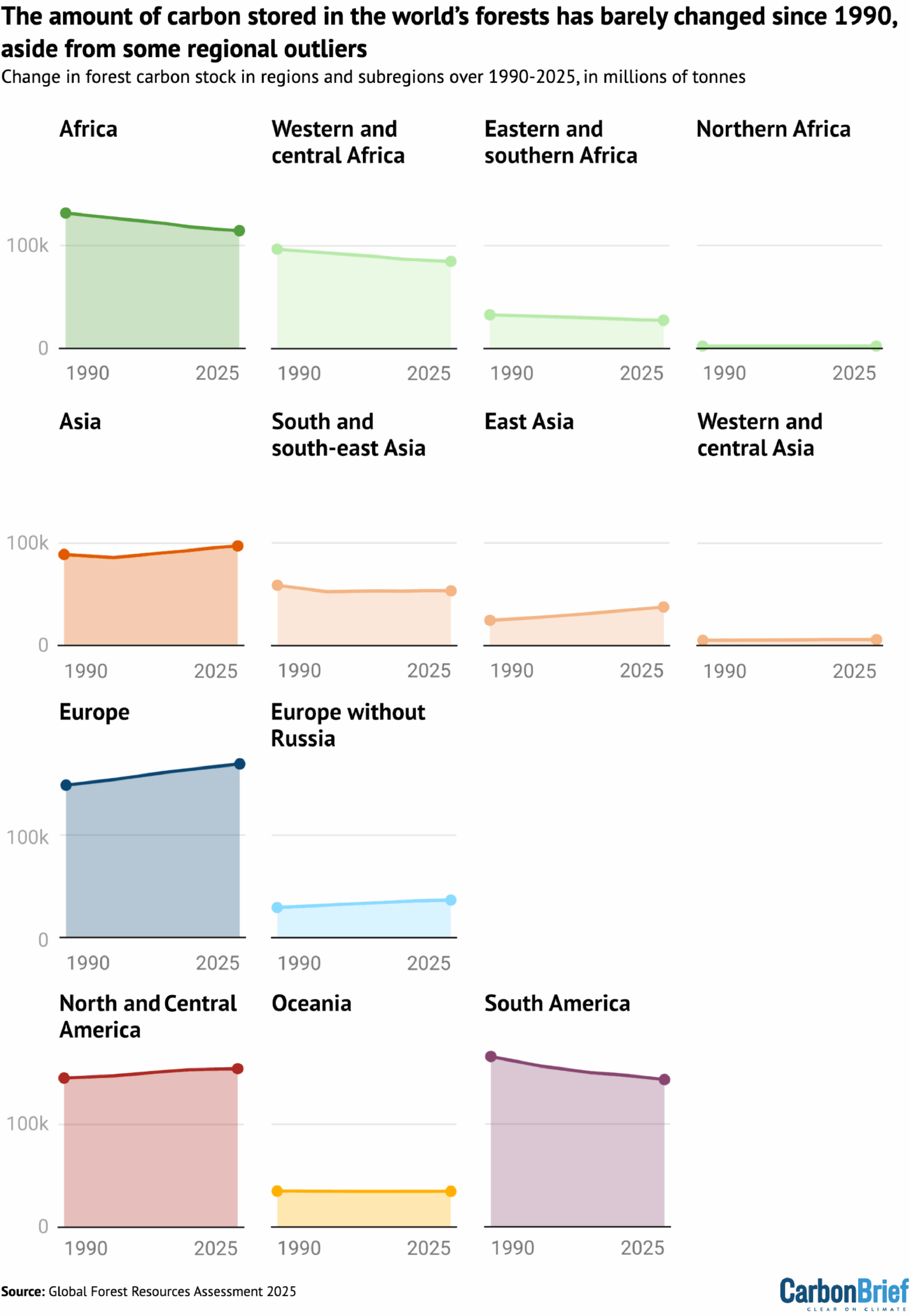
Changes in forest carbon stock by region and subregion of the world over 1990-2025. Source: Global Forest Resources Assessment 2025
The “carbon stock” of a forest refers to how much carbon is stored in its trees and soils. Forests are among the planet’s major carbon sinks.
The new report estimates that forests stored an estimated 714bn tonnes, or gigatonnes, of carbon (GtC) in 2025.
Europe (including Russia) and the Americas account for two-thirds of the world’s total forest carbon storage.
The global forest carbon stock decreased from 716GtC to 706GtC between 1990 and 2000, before growing slightly again by 2025. The report mainly attributes this recent increase to forest growth in Asia and Europe.
The report notes that the total amount of carbon stored in forests has remained largely static over the past 35 years, but with some regional differences, as highlighted in the chart above.
The amount of carbon stored in forests across east Asia, Europe and North America is “significantly higher” now due to expanded forest areas, but it is lower in South America, Africa and Central America.
Several studies have shown that there are limitations on the ability of forests to keep absorbing CO2, with difficulties posed by hotter, drier weather fuelled by climate change.
A 2024 study found that record heat in 2023 negatively impacted the ability of land and ocean sinks to absorb carbon – and that the global land sink was at its weakest since 2003.
Another study, published in 2022, said that drying and warming as a result of deforestation reduces the carbon storage ability of tropical forests, especially in the Congo basin and the Amazon rainforest.
5. Around one-fifth of the world’s forests are located in protected areas
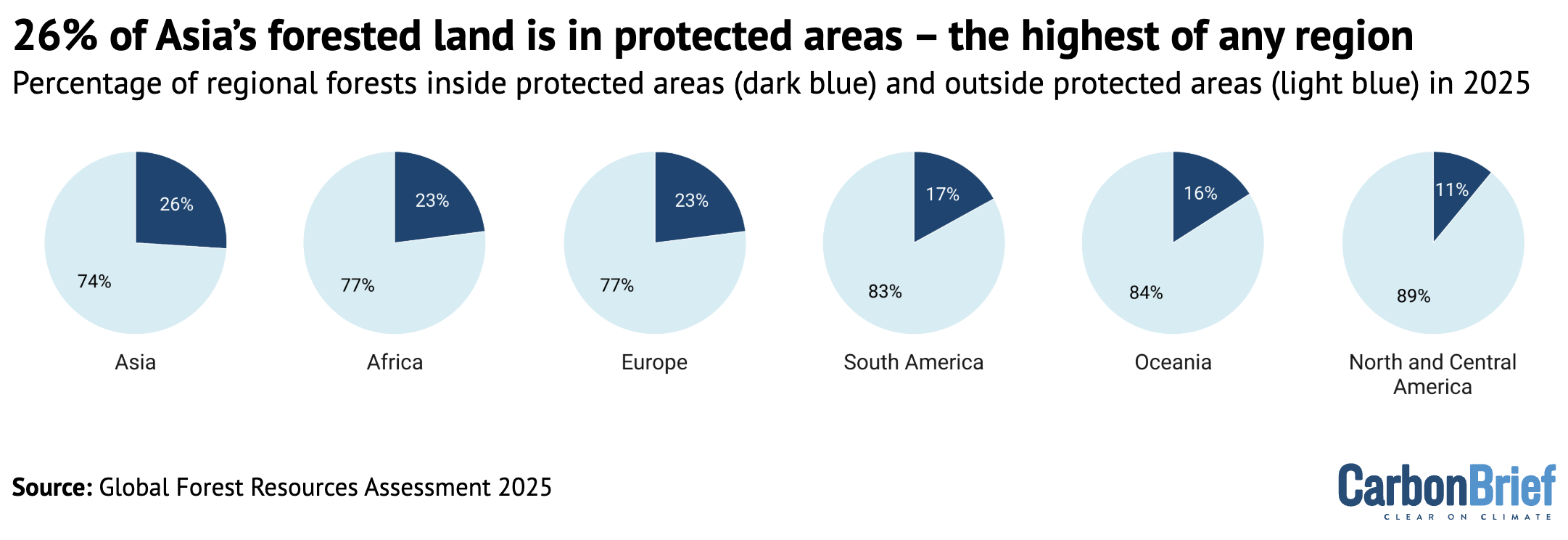
The percentage of forest land in Asia, Africa, Europe, South America, Oceania and North and Central America contained inside protected areas (dark blue) and outside protected areas (light blue) in 2025. Source: Global Forest Resources Assessment 2025
The amount of forested land located in protected areas increased across all regions between 1990 and 2025.
For an area to be considered “protected”, it must be managed in a way that conserves nature.
Around 20% of the world’s forests are located in these protected areas, the new report finds, which amounts to 813Mha of land – an area almost the size of Brazil.
Nearly every country in the world has pledged to protect 30% of the Earth’s land and sea by 2030. However, more than half of countries have not committed to this target on a national basis, Carbon Brief analysis showed earlier this year.
Almost 18% of land and around 8% of the ocean are currently in protected areas, a UN report found last year. The level is increasing, the report said, but considerable progress is still needed to reach the 2030 goal.
The new UN report notes that Europe, including Russia, holds 235Mha of protected forest area, which is the largest of any region and accounts for 23% of the continent’s total forested land.
As highlighted in the chart above, 26% of all forests in Asia are protected, which is the highest of any region. The report notes that this is largely due to a vast amount of protected forested land in Indonesia.
Three countries and one island territory reported that upwards of 90% of their forests are protected – Norfolk Island, Saudi Arabia, Cook Islands and Uzbekistan.
The post UN report: Five charts showing how global deforestation is declining appeared first on Carbon Brief.
UN report: Five charts showing how global deforestation is declining
Climate Change
Federal Appeals Court Pauses Litigation Over Florida’s Alligator Alcatraz
The Trump administration had sought the stay of proceedings in the case, arguing its attorneys were furloughed during the government shutdown. The plaintiffs say the administration is picking and choosing which cases to litigate.
A federal appeals court paused litigation Wednesday brought by environmental groups over Florida’s Alligator Alcatraz, the hastily assembled Everglades detention site where the Trump administration aims to incarcerate and deport thousands of undocumented migrants.
Federal Appeals Court Pauses Litigation Over Florida’s Alligator Alcatraz
Climate Change
Breach of Contract or Constitutional Crisis?
An appellate court will determine how to handle the Trump administration’s cancellation of hundreds of climate and environmental justice grants.
The U.S. Fourth Circuit Court of Appeals in Richmond, Virginia, heard arguments Thursday on whether the Trump administration’s cancellation of billions of dollars in environmental and climate grants earlier this year violated the Constitution or was merely a contract dispute.
-
Climate Change2 years ago
Spanish-language misinformation on renewable energy spreads online, report shows
-
Climate Change2 months ago
Guest post: Why China is still building new coal – and when it might stop
-
Climate Change Videos2 years ago
The toxic gas flares fuelling Nigeria’s climate change – BBC News
-

 Greenhouse Gases1 year ago
Greenhouse Gases1 year ago嘉宾来稿:满足中国增长的用电需求 光伏加储能“比新建煤电更实惠”
-
Greenhouse Gases2 months ago
Guest post: Why China is still building new coal – and when it might stop
-

 Climate Change1 year ago
Climate Change1 year ago嘉宾来稿:满足中国增长的用电需求 光伏加储能“比新建煤电更实惠”
-

 Carbon Footprint2 years ago
Carbon Footprint2 years agoUS SEC’s Climate Disclosure Rules Spur Renewed Interest in Carbon Credits
-
Renewable Energy3 months ago
US Grid Strain, Possible Allete Sale

